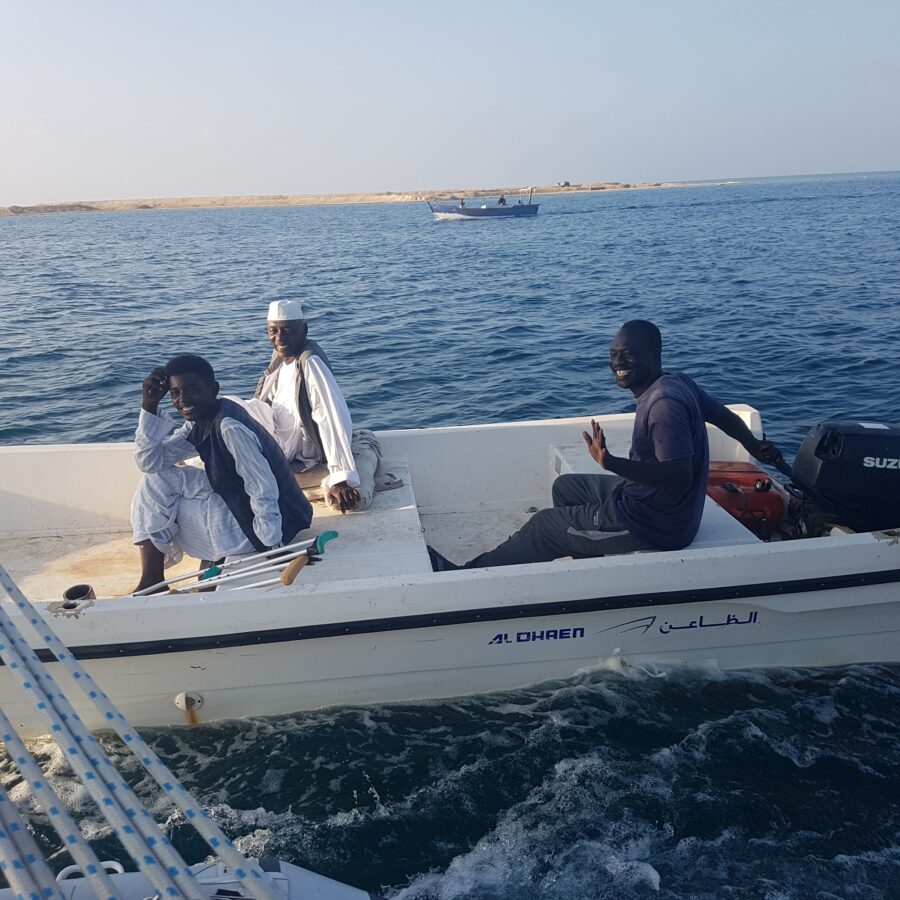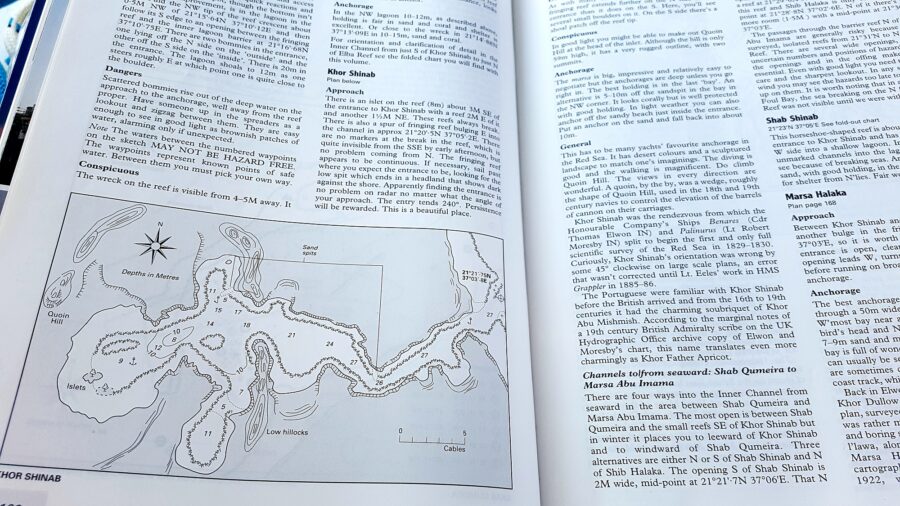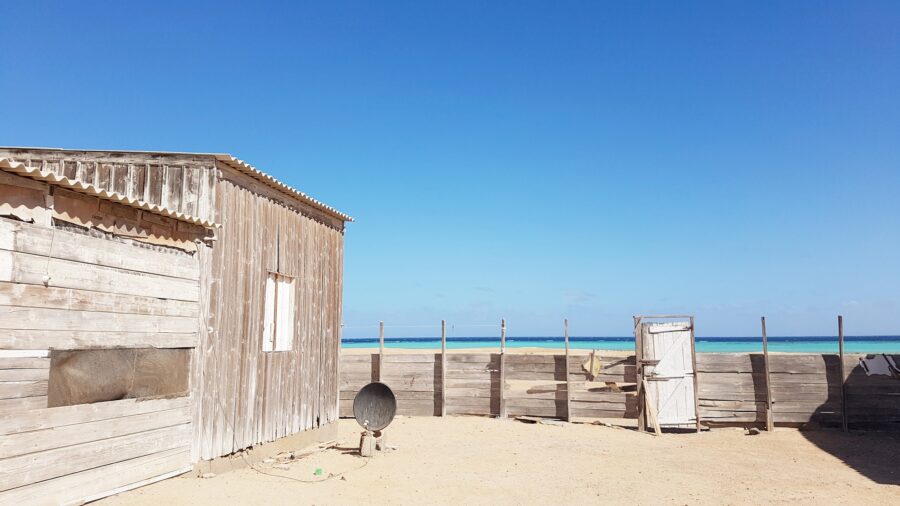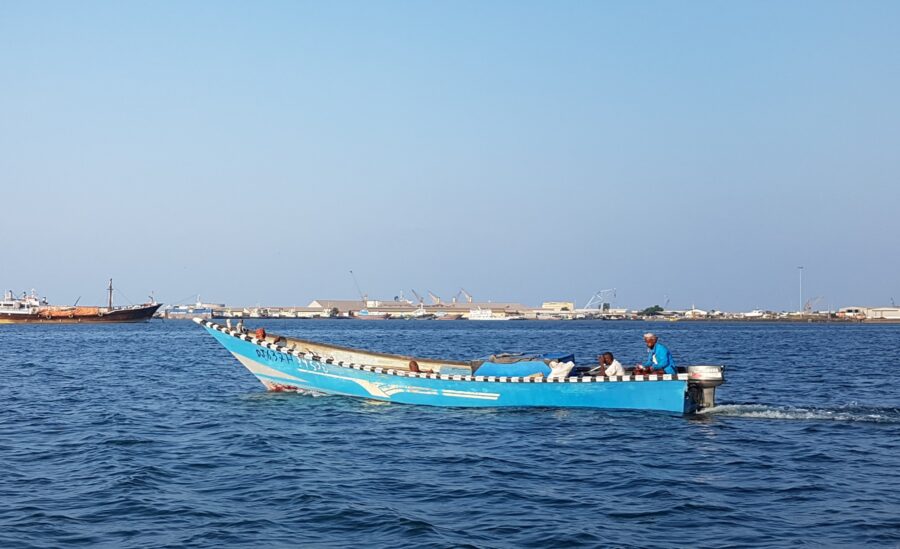
Merry Christmas from Sudan!
When we left Kenya in the middle of September we were headed directly for Djibouti, then up the Red Sea to the Suez Canal, into the Med in plenty of time for Christmas. We even had a marina booked for November in Tunisia. However, our detour to Oman to repair our engine took up a month of that time and we didn’t arrive in Djibouti until November. We still have a very long way to go, 1350 miles up wind to the Suez Canal and Christmas is almost here.
Djibouti
Once our agent Ahssan had checked us in to Djibouti, which took four days, we were allowed to go ashore and check out this city (which is the same name as the small country).
We weren’t intending on staying long in Djibouti. After our 7-day passage from Port Salalah, we just needed to top up our Diesel and replenish our fresh food ready for the Red Sea passage. We have been forewarned that we could be in very remote anchorages, waiting for days or weeks at a time, for the right weather, to continue, so we needed plenty of provisions. At this time of the year strong northerlies blow almost all the time, and you really can’t beat into them because of the big nasty steep seas these winds generate. We were advised to be prepared to just sit it out and wait. Patience, patience.
But while at anchor in the Port area, we were entertained by the parade boats coming and going, fishing boats and tourist boats taking guests out to a local island to dive on the reefs there, although there were very few foreign tourists at this time. There was one other cruising yacht here with whom we were hoping to buddy boat with up the Red Sea, but they decided to leave and head straight through, without stopping along the way. What a shame.
Because of the strategic position of Djibouti at the western tip of the Gulf of Aden, it was interesting to see the numbers of international war ships pulling in here, using this as their base to help patrol for pirates in this region.
Djibouti was a French colony from 1862 until their independence in 1977, which explains why the main languages spoken here are French and Arabic. Also finding a French “Geant” supermarket within walking distance from our anchorage was a bonus. I was able to stock up on more delicious cheeses and meats and spices..
We were also lucky enough to be here when the Annual African Textile Exhibition was on, Djibouti’s turn to host the event. This turned out to be a highlight of our stay here.
Soon it was time, the weather looked good for us to lift anchor and head for the narrow Bab El Mandeb Channel which separates the Gulf of Aden from the Red Sea. This is where weather and wind patterns become very unpredictable. We use our Predict Wind forecasting program to get an idea of the winds ahead.
The Bab El Mandeb Channel is a very busy shipping channel for boats heading north and south along the 1500nms to and from the Suez Canal. We sailed just outside the designated shipping lanes, but at any one time we could have 60 to 80 ships come up on our AIS monitor. We did see some that passed within a mile or so from us and were surprised to see that there were also those that did not have their AIS on. We were on constant watch, day and night.
Unfortunately, Eritrea has closed its borders to all tourism, so we had to sail 550nms past this coastline with so much fascinating history and head straight for Sudan, a country where a military coup had recently been declared. This coup was mainly in the capital city of Khartoum, 1000 kms inland. So, fortunately they were still welcoming visiting cruising yachts along the coast. Sudan is the largest country in Africa and one of the poorest in the world.
Sudan

Ready for our arrival in Sudan 
Our cockpit where we spend most of our time
We were heading for the ancient city of Suakin to officially check in to Sudan, but after 5 days at sea, we rested at a couple of anchorages along the coast before arriving in Suakin.
At our first stop, in Khor Nawarat, we got a very un-friendly “welcome” from a boatload of men, ramming right into the side of Mai Tai, saying they were from the Sudanese Navy, demanding our papers and telling us to leave. They broke the lifelines and bent our railings when they hit us. They refused to leave us alone so Kay played the “distraught old lady” hoping that one of the young ones might take pity on us, thinking of his grandmother!! It seemed to work. Whatever, they eventually left us alone, then a couple of them came back to apologise the following day.

Sudanese Navy ?????????
Welcome to Sudan. There wasn’t much ashore, but we needed to get off the boat and go for a walk. So, this is Sudan. Desert and more desert, mountains in the far distance and nothing but flat desert in between.
Suakin
Just past the new ferry terminal at Suakin, we have to pass through a very narrow channel past Suakin Island, to get to our anchorage. Another yacht lies at anchor, but there was no one onboard.

Sailing past the remains of the old Bank Building on Suakin Island
We have been in communication with an Agent, Mohammed Abubaker, who will take care of all our checking in to Sudan for us, so it was a pleasure to finally meet him when he came out to Mai Tai to welcome us to Sudan, He took all our necessary paperwork for our entry into the country. He is so efficient and a real gentleman.
Suakin Island, has a very rich and fascinating history dating back thousands of years and I can’t wait to visit to find out more.
For 3000 years the port on the small island of Suakin was strategically crucial for trade to powerful empires in the east.
Later, Suakin Island became the main port for African Muslims taking dhows across the Red Sea on pilgrimage to Mecca in Saudi Arabia, and soon became very wealthy with magnificent buildings of stunning coral blocks and beautifully carved woodwork. Suakin was the height of Medieval luxury on the Red Sea.
In the 18th century, the port became the hub for the slave trade. But when slavery was abolished, business in Suakin began to slow. A new port was being built in Port Sudan, 50 miles up the coast, and once that opened in 1905, most people abandoned Suakin to move to the bigger city. The coral buildings, soon crumbled and fell into the heap of rubble we see today.
Paintings that I saw at the museum show what the Island looked like just 140 years ago.
The Sudanese government has recently signed a 99yr lease with Turkey with their promise to rebuild the island to its former glory.
Today, the city of Suakin with a population of about 44,000 is extremely poor. Only a few remains of the past remain as reminders.
There is no running water, nothing grows, a small amount of power is brought down from a dam up in the mountains and donkeys are the main mode of local transport.


The water carrier

Typical street scene 
Fresh food stall

Tailor for men’s clothes 
Bread delivery

Woven mats are still used as floor coverings 
Pottery for grains and spices

Prayer time has finished at the Mosque 
Small fishing harbour and dinghy dock
Moving on up the coast of Sudan we find dozens of deep bays called marsas that offer good protection for anchoring as we head north.
We were watching the weather carefully to pick the ideal day to leave.
We finally got our weather window so lifted anchor at dawn, set the sails and enjoyed a beautiful overnight passage all the way to our next anchorage called Marsa Inkeifal, 140 nms up the coast.
It was a lovely surprise to see another yacht at anchor in this large protected bay. I got very excited at the thought of other cruisers, chats, sharing of stories and hanging out with other like-minded people. Our new cruising friend was a Frenchman named Jacques on a 54ft ketch. He was such a wealth of knowledge, having spent the past 16 years in Sudan, taking diving charters to the beautiful reefs that the Red Sea is famous for. We really enjoyed his company and are keeping in touch regularly now.
Looking out from the cockpit, it seemed that the landscape was a repetition of the same flat sand dunes, no villages, no roads, no hope. But just as I was thinking that it crossed my mind that it was missing a few camels to complete the picture, A moment later, right in front of my eyes, was a whole herd of camels wandering along the shoreline, being driven by a herdsman on camelback. Is this for real??
Our walk ashore revealed signs of other visitors, dusty, sandy roads leading nowhere, an upturned boat, vehicle tracks, barefoot prints heading in both directions and camel hoof prints. Over the next few days, we saw the odd spearfishermen park their car as they went to spend hours diving off the outer reefs. A few mangroves here broke the monotony of the expanse of sand.
While in this calm anchorage, Lane took the opportunity to change the fuel and oil filters, as they were due. He also fixed 2 of our 3 bilge pumps that were not working properly due to perished rubber diaphragms and clogged filters.
Oh yes, another thing we discovered that we had a leak at the bottom of one of our water tanks. Our aft tank was completely empty!!! No wonder there was so much water in the bilge lately!! This, too, Lane managed to repair. He found out that an old pipe coming out of the bottom of the tank had a small crack in it. Apparently, this pipe used to feed water to the galley sink. He had put a cap on it years ago, but now the pipe itself was leaking. He found a piece of hose in his locker that slipped over the pipe and he locked it down with a couple of hose clamps. Good to go!
After almost a week we got a weather window to take another bite of our passage north. Once again, we were up at dawn with the rising sun, everything was ready for another overnight passage, but…. the engine wouldn’t start!!!
Nooo!!!!! Not again?
We are about to enter the northern part of the Red Sea where we expect to be forced to motor most of the time. When the wind isn’t blowing a gale from the north, it drops to nothing at all, and that is when we go.
Now, with no engine, we really have to think seriously of our options. Lane thinks the problem was that there was a pocket of air left in the fuel filter that he didn’t flush out completely. He even questioned whether we could have blown the head gasket! This could be a major problem.
Another change of plan.
We couldn’t risk continuing, so we made the decision to wait for a northerly wind and sail back down to Suakin, 120 miles to the south of us. We contacted our Agent/friend Mohammed, who assured us he knew of an excellent diesel mechanic and he would be ready to help us as soon as we arrived. Here goes possibly another 2 weeks delay in getting to our destination, the Suez and Med. How long will we need to wait for parts in Sudan, of all places.
It is much easier sailing south from Marsa Inkeifal than north and we had a great sail down and we had the added excitement of entering the Port Suakin Channel and anchorage under mainsail and spinnaker. I bet they don’t see that here everyday! We did have our dinghy tied alongside to use for maneuvering just in case the winds died as we entered the Port. As it happened, Mohammed had come out to meet us in his boat, prepared to give us a tow if necessary.
We needed to check back in to Port Suakin again with more port fees and an extension on our shore passes so we gave Mohammed all the necessary paperwork to get this done. Also, we had him buy us a new Sim Card that would work all the way up the coast of Sudan.
The following morning Mohammed came out to the boat with his diesel mechanic. It took him no time at all to diagnose the problem. It was just some air in the diesel injection pump and the pump required a minor adjustment. The engine coughed once and was running sweet. What a relief – no parts required!


The diesel mechanic on the left, our agent on the right
Our fridge was not working either and we had been keeping things cool with big blocks of ice, which we bought the last time we were here in Suakin. Mohammed also brought down a refrigeration specialist who checked out the system for leaks and refilled the gas. Now we have a fridge again.
While here, we stocked up yet again with fresh supplies and even took a drive up to Port Sudan, (a city with a population of 480.000) to see what we could find there. As it happens, there was not much, except some mozzarella cheese and a market stall selling New Zealand apples and Kiwifruit, amazingly good condition despite the transport time. Coming back along the highway, we had to wait for a herd of camels to cross in front of us.
Now we were ready to wait for the next winds to sail back north – again!
Another sunrise departure and we were lucky enough to get perfect winds to allow us to sail overnight to the next Marsa north of Inkeifal called Marsa Shinab. Our Electronic charts plus our Red Sea Bible, make navigating these reef-riddled areas much safer. But we have to always be extremely vigilant.

The Red Sea Pilot book was written by cruisers, for cruisers and is invaluable, even with all our electronic equipment.
We had only been in Shinab one night but we were keen to get to the next anchorage as we could see on our weather prediction app that a long period of strong northerlies was coming, meaning we could be locked down for at least a week or two. We were keen to be somewhere with good internet and with some civilisation around.
As we arrived just off the entrance to Marsa Oseif the engine started to overheat. “What now?” we both said. I quickly shut the engine down and opened the engine cabinet to clouds of billowing steam. We drift/sailed out away from the narrow entrance to Marsa Oseif and let the engine cool enough that we could inspect it. As I began to add water back into the heat exchanger, I could see the water running out a small split in one of the hoses. We couldn’t fix it in that moment because I didn’t have any hose that would fit. We really needed to get into the protection of the harbour before the rising wind got too strong. So, Kay stayed below with a pitcher of water and fed it into the engine at the same speed that it was leaking out the split hose. Meanwhile, I continued to motor the last 3 miles into the harbour. I guess, technically, we didn’t have to sail in to port this time! We got in to Marsa Oseif and dropped anchor and that is where we are at present.

Naval Police station at entrance to the Bay 
Our anchorage with direct cell phone coverage
We sent a message to our friend Jacques, and explained our situation and he immediately replied that he had a spare hose onboard that we could have. Jacques hired a local guy to bring the part to us, over 100 miles across the desert on a tuk tuk. He arrived with it at 5 o’clock at night, and had to drive all the way back again. We were happy to pay him his $140. Within 24 hours we had a new, proper hose in place and the engine is running again.
I told Kay that sailing around the world is a lot like getting old. The real focus needs to be on keeping everything working until the finish line. We go for long walks each day and continue to find what seem like abandoned buildings, but there are signs of people actually living in some of these places.

Trying to stay fit with lots of walking. Out looking for palm trees.

A real life water colour painting 
Home sweet home in Sudan
There is a Navy/Police base here, a refugee camp and a small village nearby. It is a desolate, windblown place but the harbour provides good holding for our anchor in the strong winds. We can buy fish from the local fishermen and today we bought some fresh vegetables. At least we are able to keep in touch with our friends and family and get this blog off while waiting for the next weather window to continue north, which could mean seeing the New Year in while at sea.

I love the satellite dish with wee wires running inside 

Fresh groceries being delivered to the dinghy. 
Fresh fish for sale

A walk over the sand hills revealed some government offices. 
Decorative fence adorns a crumbling wall

View from the Naval Police over old painted walls 
I love these decorations of another time
Our next official clearing in port in will probably be Port Ghalib, in Egypt. We are less than 300 nms away, which seems close but if we get the wrong weather, it could be a miserable and long trip. We may make a stopover or two along the way.
We had hoped to be there for Christmas and take a trip to the Nile to visit Luxor as a Christmas present. This is relatively easy to do from Port Ghalib and offers a safe place to moor Mai Tai while we go travelling inland.
That trip will have to wait. Maybe for New Year.
Visiting this coastline of Sudan has been a real eye opener for us. Sometimes it seems as though we are living on a film set. It just can’t be happening that these people are real, living and surviving in these extremely harsh conditions. To us it seems a land of desolation and hopelessness. Of course, there is the natural beauty of the desert in stark contrast to the turquoise coastal waters and deep blue Red Sea. Yet the people we meet here are happy, friendly and giving. We will leave here with a warm respect for the Sudanese people.
Next: Dolphins welcome us to Egypt










































Wow, I am exhausted but intrigued with your travels and ingenuity!! Blessings to you guys and prayers for your continued safety !! I know many friends and family are fascinated with your travels and we are living precariously through your writings – thank you for that!! Merry Christmas to you-you are in our thoughts and prayers daily!! The family will be together on Christmas Eve at Janine’s and will share your post with them!! Love and hugs to uou!!💕🎄🙏
As we have the deepest respect for you and Kay in this harsh part of the world. Love your blogs and stories. You’re doing it guys! Living the dream (with nightmares too!). One day at a time! We all get old but would you rather it be on Maitai or in a rocking chair? Much aloha to you both and Mele Kalikimaka!
Those dolphins are amazing. It looks as though they are guiding you as they are welcoming you. What a great movie your travels would be to all of us that don’t have the tenacity to do what you both are doing. We are fortunate to live vicariously through both of you. Thank you for your blog. Safe travels and looking forward to the next chapter. XOXO
Just can’t believe how you keep going in all adversity and make the very best of everything! What an amazing experience Sudan must have been and how you must worry every time the engine fails. Hoping very much you have a good experience in the Canal and looking forward to reading all about. Email to follow with our news!